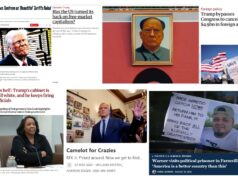by Schuyler VanValkenburg, House of Delegates Candidate, VA-72, and Sam Ulmschneider
In November 1863 at Gettysburg, President Lincoln called back to a document written in July fourscore and seven years before, to the “new nation, conceived in liberty.” His speech placed the Declaration Of Independence and its promises of equality and opportunity at the center of our national life and character. Both moments – the writing of the Declaration and its transformation by Lincoln – represented the power political mobilization, the passion and engagement of thousands of Americans, not just the efforts of those individual men.
From the beginning, the ideals of the Declaration were a collective effort. From April to July 1776, around ninety local declarations were published from New York to South Carolina. These local declarations became the foundation for the Continental Congress’ decision to declare independence – and for Jefferson’s famous words. The Congress also edited Jefferson’s original draft, cutting ¼ of its content, over the course of two days. Democratic deliberation and bottom-up activism continued to propel the Declaration’s transformation long after the Revolution. Early feminists embraced and claimed its ideals at Seneca Falls in 1848. Slaves and abolitionists wielded the Declaration in their struggle in the 1850s, and black Union soldiers, by their example, pushed Lincoln into endorsing their vision in the Gettysburg Address. During the Civil Rights movement and the other equality struggles of the 20th century, it was the power of engaged citizens that created an ever more inclusive Declaration. When Martin Luther King, in 1963, called the Declaration of Independence “a promissory note to which every American was to fall heir,” transforming it once more, he was building on decades of activism.
This day, and this document, now symbolize the idea that, in the words of Pauline Maier, “The Declaration was what the American people chose to make of it, at once a legacy and a new conception, a document that spoke both for the revolutionaries and for their descendants, who confronted issues the country’s fathers had never known or failed to resolve, binding one generation after another in a continuing act of national self-definition.”
Over time, and haltingly, America has tried to fulfill the Declaration’s promise of inclusive equality. Concrete achievements – the 13th, 14th, and 19th Amendments, Brown v. Board, the Civil Rights and Voting Rights Acts, Title IX, Obergefell v. Hodges – are mileposts on the nation’s long and incomplete journey towards the Declaration’s ideals. The roadblocks those achievements faced and can face again call us to our duty of citizen engagement and be wary of narrow understandings of equality. It took 100 years to restore the 14th amendment against Jim Crow. Now, 100 years after the 19th Amendment, we still have too few women in elected office. After decades of struggle, it is still legal in Virginia to discriminate against the LGBTQ community in employment and housing.
We must act together to keep the Declaration’s legacy from being abandoned and distorted. To live up to the ideals so eloquently articulated by Jefferson, and transformed by Lincoln, Susan B. Anthony, Martin Luther King, and the millions of American citizens who fought for progress, we must fight for them in the modern context. We must stand up to Muslim travel bans, to laws that discriminate against the LGTBQ community, to actions that persecute people based on their ethnicity in order to fight for an America that faces its challenges in an inclusive way.
But equal rights and respect under the law were only parts of what Jefferson articulated in the Declaration. The “pursuit of happiness” was also crucial to his vision – though in 1776 it may have meant the opportunity for landownership, whereas the “pursuit of happiness” today means access to economic opportunity for all. The great transformations of the Declaration also paid attention to this side of its legacy. Lincoln supported new infrastructure, the Homestead Act, land grant universities, and other programs to expand everyone’s economic opportunity. Martin Luther King fought for urban jobs and supported unionization, Betty Friedan demanded women’s equal inclusion in the American workplace. And Barack Obama fought for crucial securities such as accessible healthcare and equal pay for equal work. This side of the Declaration is ours to fulfill in 2017, too. We must expand access to education, like an expanded version of the Virginia Credential Grant, invest in new energy sources, and build secure, middle-class jobs – or else we fail to enable our citizens to pursue happiness.
In American Scripture, Pauline Maier says, “the redefinition of the Declaration was a collective work by Americans who struggled over several generations to establish policies consistent with the revolutionary heritage as they came to understand it.” Today, let’s take this holiday to celebrate one of the most vital documents in the history of human freedom, but then get back to work fulfilling its potential tomorrow. The future of the Declaration of Independence and its legacy depends on our ability to go out and make its words become true in practice – at the ballot box, in our activism, and in our everyday actions.



![Monday News: Trump’s Lunacy Pushes China, Russia, India, etc. Together; “Happy Labor Day. Donald Trump and Elon Musk Are Screwing Workers.”; “Where is the [media’s] intense focus on Trump’s failing health?”; ““Trump says he is not a dictator. Isn’t he?”](https://bluevirginia.us/wp-content/uploads/2025/09/montage0901-238x178.jpg)










![Monday News: Trump’s Lunacy Pushes China, Russia, India, etc. Together; “Happy Labor Day. Donald Trump and Elon Musk Are Screwing Workers.”; “Where is the [media’s] intense focus on Trump’s failing health?”; ““Trump says he is not a dictator. Isn’t he?”](https://bluevirginia.us/wp-content/uploads/2025/09/montage0901-100x75.jpg)